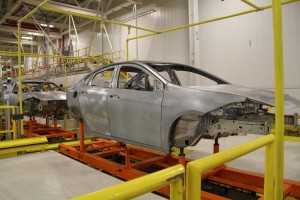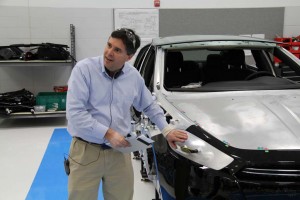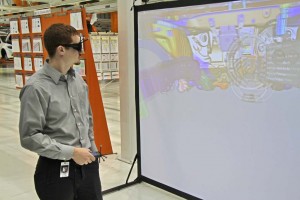It’s one of the industry’s older plants and one that has not had an especially distinguished history. Not until now, anyway. But going forward, Chrysler officials are determined to transform their Belvidere, Illinois assembly plant into one of the best in the business.
That can be measured in a variety of ways, of course, and Chrysler clearly hopes to turn the facility, two hours outside of Chicago, into one of the industry’s most productive. But volume alone won’t matter, cautions Senior Vice President Doug Betts, if the new Dodge Darts starting to roll off the Belvidere line can’t match the quality of the best competitors like the Honda Civic or Toyota Corolla.
“We have to be substantially better” than ever before, says Betts, who built his reputation during lengthy stints for both Toyota and Nissan before joining Chrysler in 2007. That’s especially difficult he says, as he begins a tour of the Illinois plant, for a company that has long lingered “at the bottom” of the quality charts.
While there are signs that has begun to change, the executive says it’s one thing to go back and fix problems with an old car. It’s another to try to get everything right with an all-new model like the 2013 Dodge Dart. It is a time when you face your “biggest risk,” admits Betts, Chrysler’s quality guru, because “virtually everything changes” in a plant. This time, however, Chrysler has decided to use that as an opportunity to get things right.
There are more than 5 million square feet of factory space under the sprawling facility’s roof. That includes an all-new body shop specifically designed for the Dart, which is based on a platform shared with Chrysler’s Italian partner Fiat.
(For a review of the 2013 Dodge Dart, Click Here.)
There are also a number of other new features added to the plant, including a so-called Launch Center in which every detail of Dart assembly – down to the tightening of the smallest bolt – has been simulated. Team leaders who’ll oversee each basic operation have gone through extensive training using everything from bulletin boards designed to track and isolate problems to a state-of-the-art 3D simulator that “Avatar” director James Cameron might appreciate.
Wearing a special set of glasses, line workers can use the system to step inside a virtual assembly line and digitally assemble a new Dart. The system can help isolate problems that might cause a quality snag or lead to such worker health-related problems as repetitive stress disorder.
“We’ve been taking the best people off the floor” to run through the Launch Center, “because who knows better what they are doing. And we let them design their own work stations,” explains Bob Allen, who oversees the start of production of what is to become the most important Chrysler product for 2013 – and possibly beyond, as it could boost the maker’s recent momentum or lead it to come crashing down.
While union workers often take the blame for quality problems, Chrysler officials acknowledge the push to deliver a flawless Dodge Dart had to begin the moment design and engineering work began. And quality is a multi-faceted term that means more than just building a reliable vehicle. It’s also about customer perceptions about seemingly small matters like the size of the gap between hood and fenders.
Ensuring gaps are both small and consistent is one of the tasks for the Belvidere plant’s new Metrology Lab. It operates with clean room precision, visitors slipping on booties and coveralls to minimize dust in the air. It is filled with a variety of machines, some relying on high-tech laser vision systems, others using more old-fashioned mechanical devices. But the goal is to quickly spot problems, such as a stamping machine that might be slightly out of sync.
Parts brought in by suppliers are subject to inspection, as well. Like its competitors, Chrysler now relies on outside parts makers for the vast majority of components it uses in a product like Dart, so as Betts and his colleagues work through the Metrology Lab a team of inspectors are comparing some pre-production headlamps with a metal prototype carefully carved into the perfect dimensions.
The ultimate goal is to stop defects and other problems before they get onto the assembly line. But snags will always get through and workers are now encouraged to pull an “andon” cord to halt production, if necessary, if something seems wrong. Additional, automated inspection systems – including one cluster known as “the vision farm” — throughout the plant can effectively do the same thing.
Meanwhile, a large number of the initial vehicles produced in Belvidere will be subject to post-production driving and other tests. That will continue at a slightly reduced rate once the factory gets fully up to speed.
If all goes well, that means another vehicle – including the Jeep Compass and Patrio models produced alongside the Dart – will pass through each work station every 42 to 44 seconds. On a double shift that will work out to over 1,000 a day, computes Betts.
“I don’t know how we could survive without getting all this stuff right,” he says.
But those who know Betts – who was named one of the 10 people to watch in the industry by Automotive News in 2008 – think he has a good shot at getting it right. “Doug Betts has a single focus on bringing Chrysler back into the field,” says David Champion, director of automotive testing at Consumer Reports magazine.
The test is about to begin. The first Dodge Darts will soon be in customer hands and later this year key quality arbiters, such as Consumer Reports and J.D. Power and Associates, will be studying the results. A strong endorsement could position Chrysler as a serious contender in a market segment where it has long been an also-ran. A thumbs down on quality could severely impact the company’s long-term viability.




